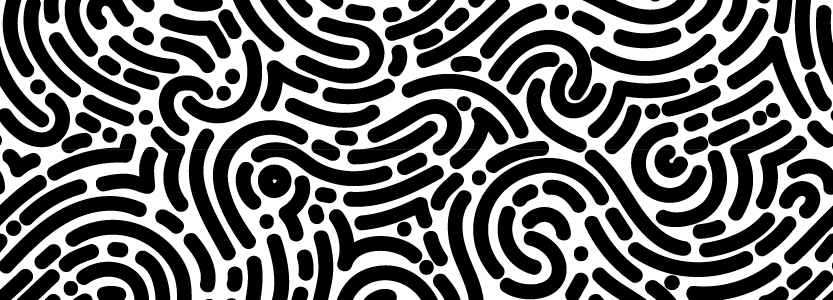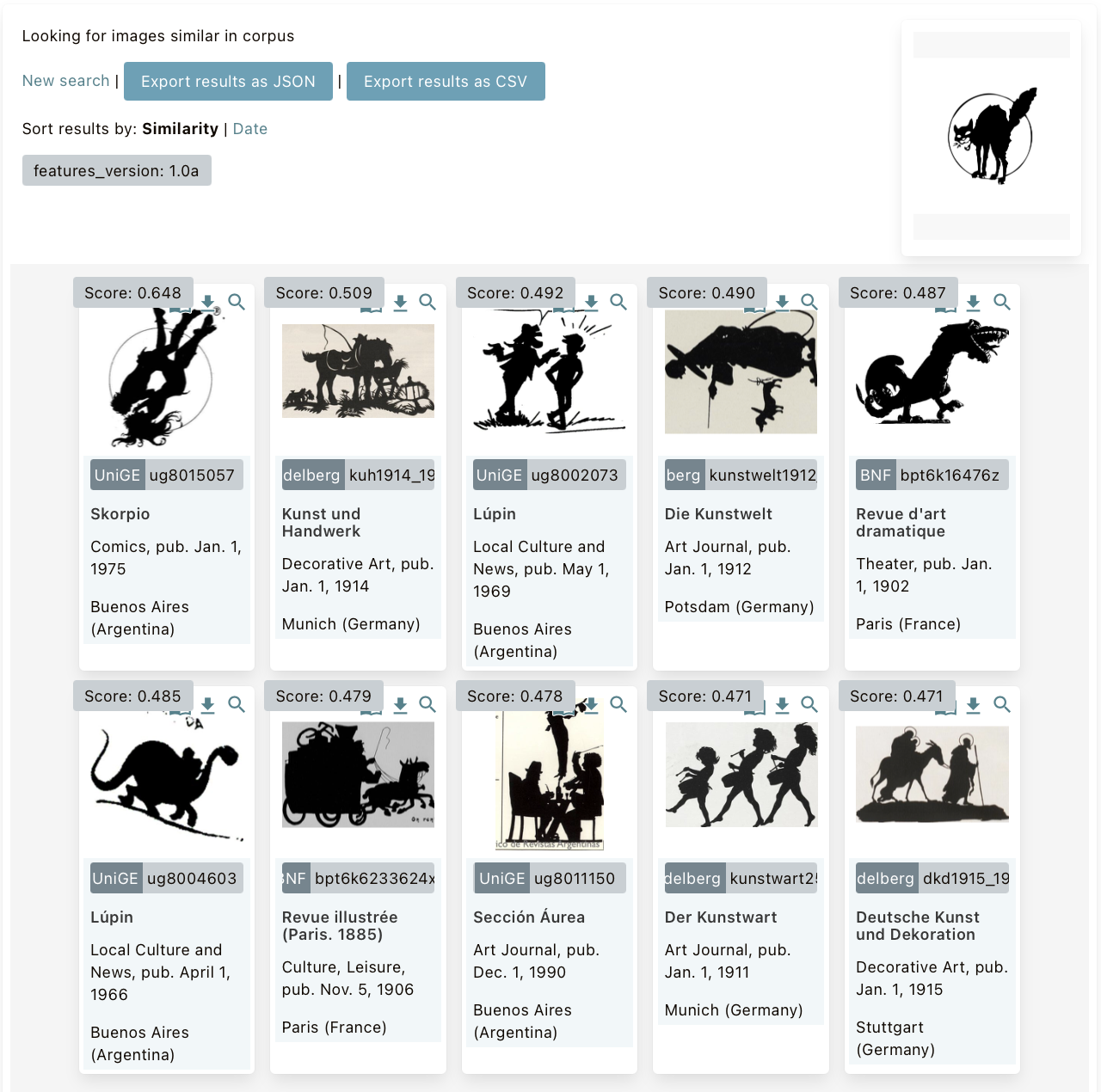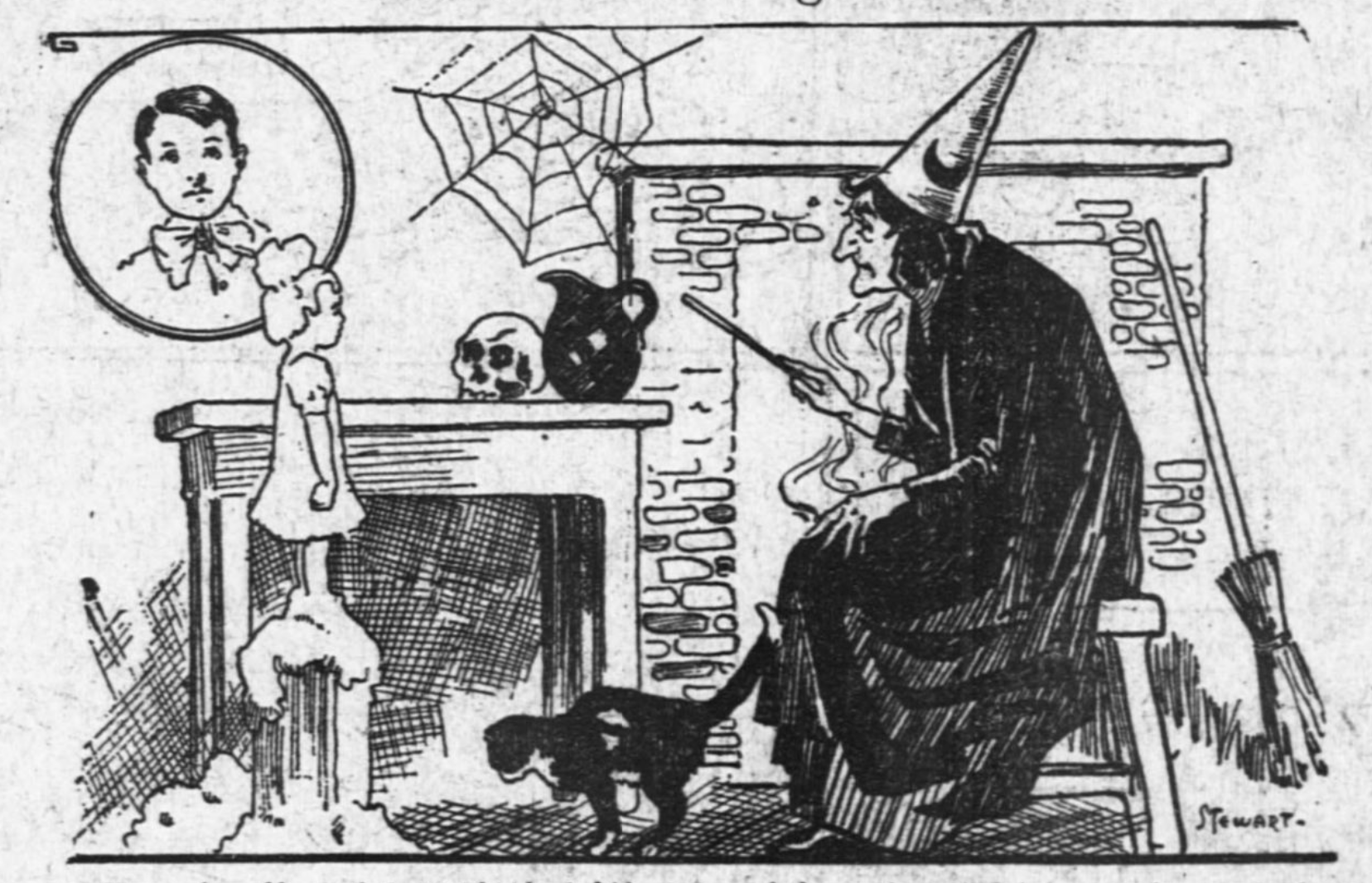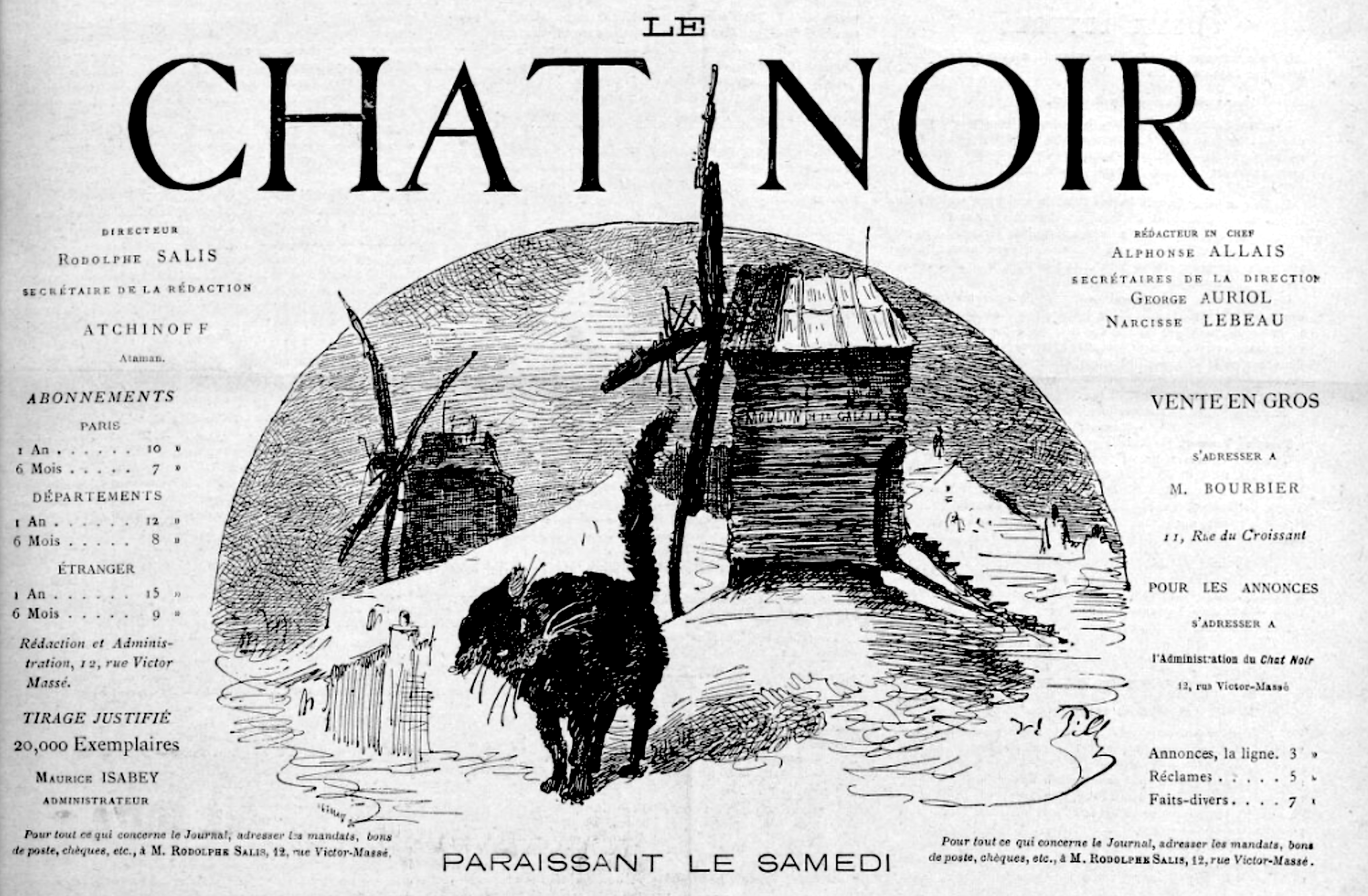The black cat. Between witch hunts, fin-de-siècle bohemia and luxury marketing
Marie Barras
A CAT LOST - FIVE DOLLARS REWARD for his restoration to Mark Twain, No. 21 Fifth avenue. Large and intensely black; thick, velvety fur; has a faint fringe of white hair across his chest; not easy to find in ordinary light.
Kansas City Star, 5 avril 1905.
"Not easy to find in ordinary light."
This could qualify our research in the Visual Contagions corpus: thanks to our algorithms, numerous similarities, correspondences, circulations are brought to light. Digital tools allow us to see differently, sometimes with a strange poetry. You have to arm yourself with a digital flashlight to find your way through the Visual Contagions atlas, while allowing yourself to navigate sometimes blindly, thus allowing discoveries by serendipity.
With Halloween approaching, the idea was to question the symbols of this holiday with its iconography and codes so visual, and more particularly its spectral bestiary. Torch in hand, we went into the meanders of Explore to try to find the trace of gloomy and disturbing creatures, hoping that the digital halo would enlighten our discoveries...
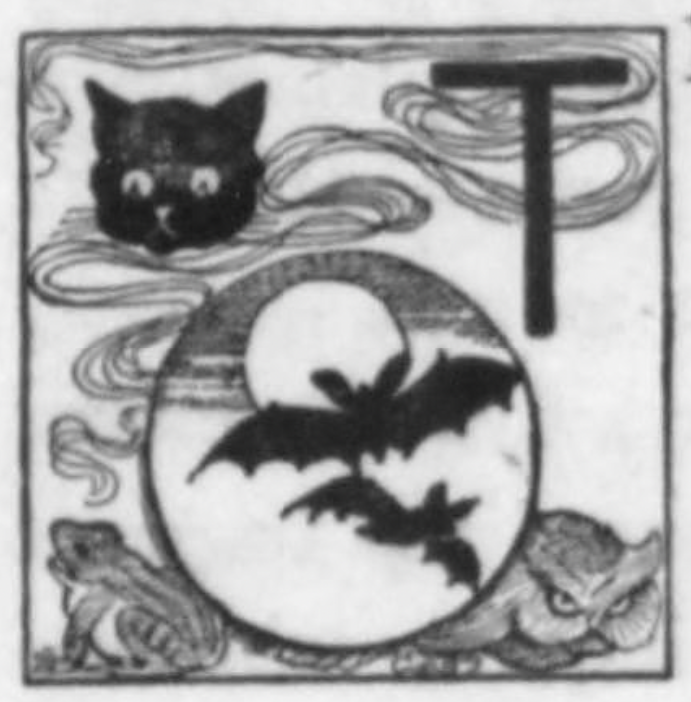
--
Letterhead from The Black Cat magazine, June 1896, vol. 1, n°9
The bestiary of witchcraft seen through the digital eye
Where nothing is as simple as it seems...
We have seen it together in the previous episodes, the Explore tool developed by the Visual Contagions project allows to search an image and to discover its circulation through our corpus.
In this Halloween-esque month of October, haunted by creatures as enigmatic as they are monstrous, we asked ourselves: how did the bestiary of witchcraft circulate in the press? Who, of the toad, the black cat or the bat, left its spectral trace in the newspapers of the end of the century?
The approach seemed simple, instant results were just around the corner :
- Search for an image of a bat in a search engine,
- Load it in Explore,
- Then wait for the response...
But the machine is sometimes like a cat: it brings back its prey, a wonderful gift in its eyes, but we see a dead mouse in our so feng shui interior!
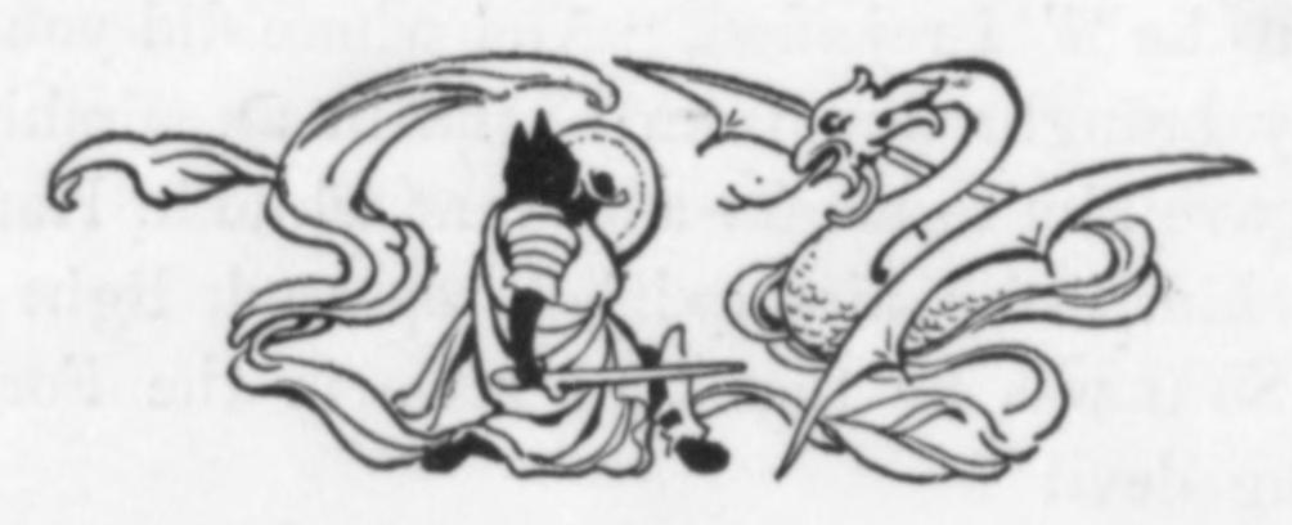
--
Image from The Black Cat magazine, October 1900, vol. 5, no. 61.
First try
In search of bat images…
The algorithm brings back images of art deco ornaments, men's suits or a shoe with a Batman-like heel.
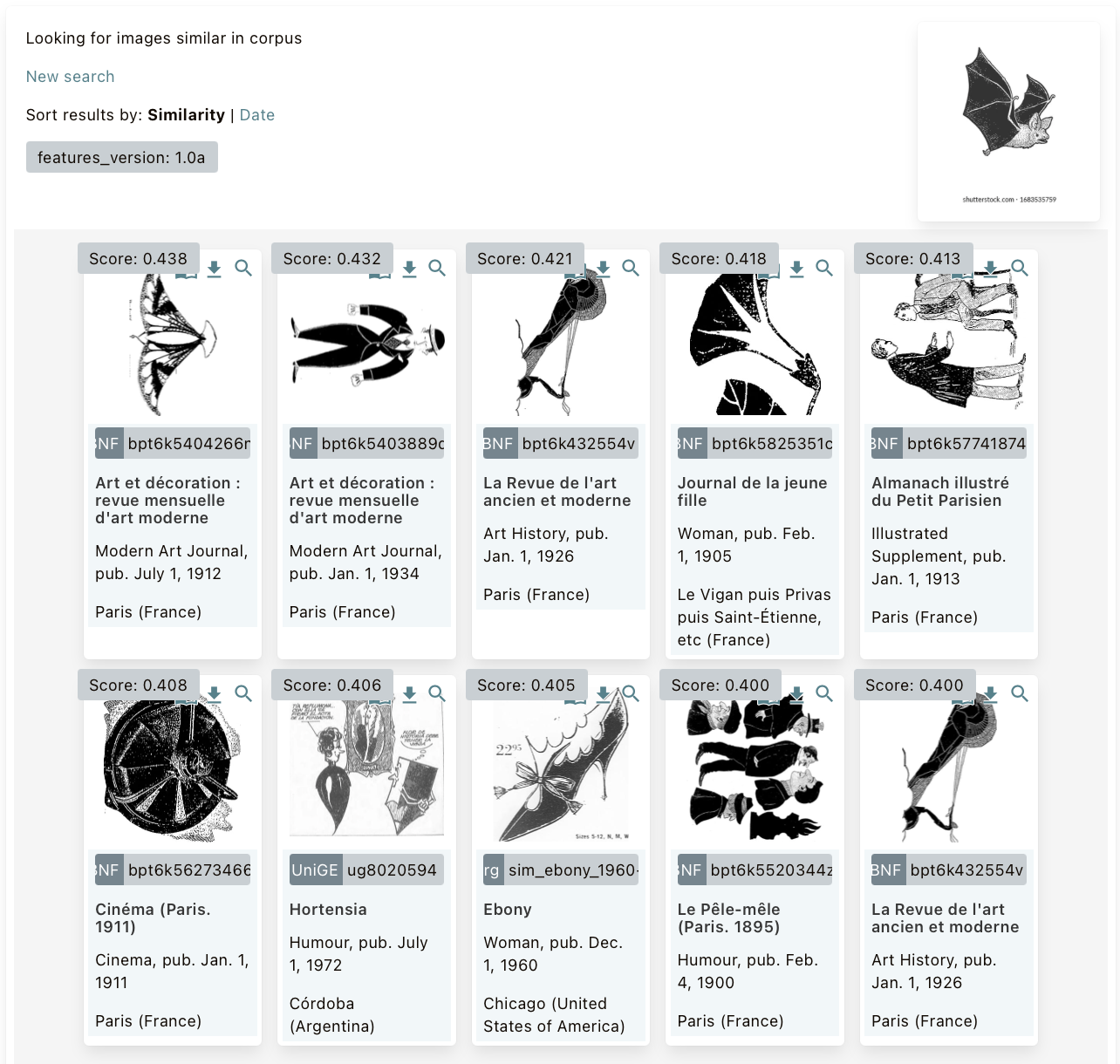
Second try
let's look for toads…
This time, the machine doesn't understand much, except maybe the texture of its skin.
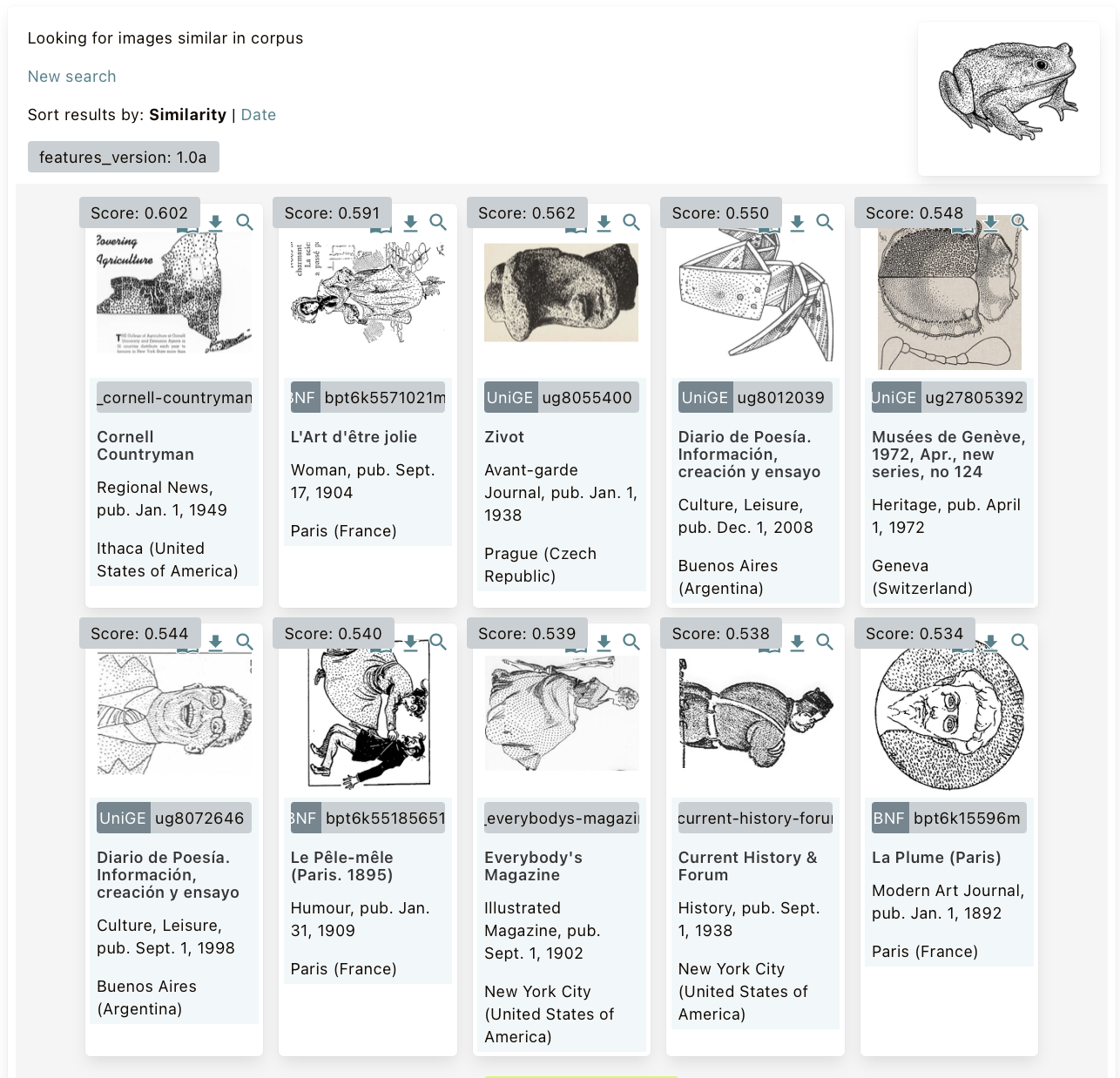
The black cat, almost absent from our corpus? We see in this problem a very contemporary echo: black cats are statistically less adopted, notably because of superstition residues...
But in the 21st century, the circulation of the black cat image still faces new obstacles, born from our time and its obsession with selfies[1].Too dense, too black, the fur of the black cat absorbs light. It represents a challenge for the cameras! With closed eyes and low light, the feline will be captured on the digital film as a black silhouette... And the machine will follow the same reflexes as our algorithm.

Being a black cat on Halloween... is it really such a good idea?
The issue of adopting black cats becomes even more delicate around Halloween, with some shelters preferring to postpone adoption for fear that they will be abandoned along with the decorative pumpkins, relegated to a box in the basement[2].
PETA even warns black cat owners that black cats are more likely to fall victim to bad faces at this time of year[3].
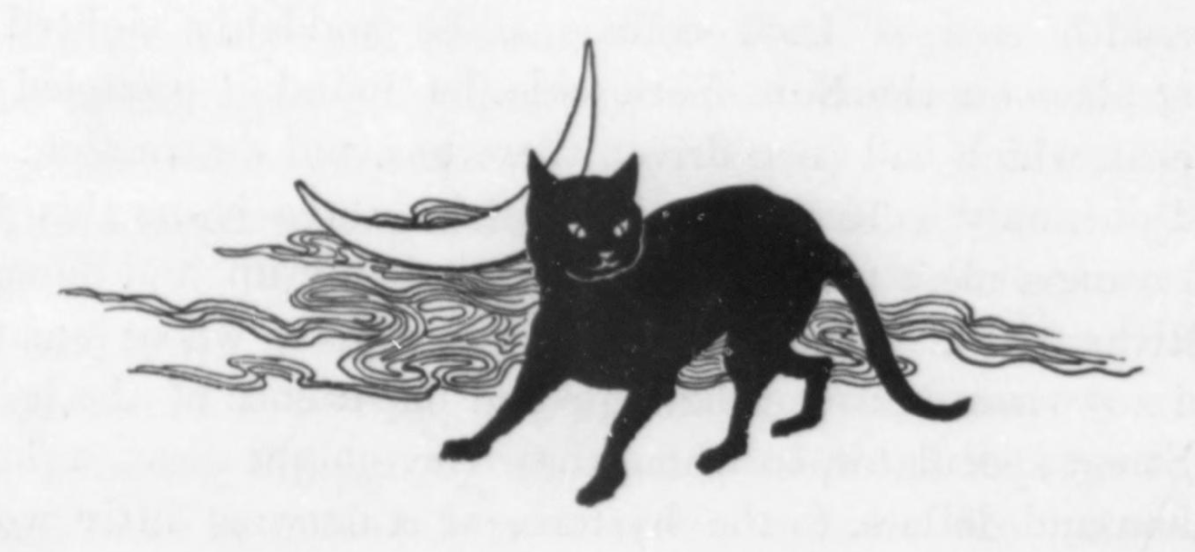
--
Image from The Black Cat magazine, October 1895, vol. 1, n°1.
But where does the link between the black cat and Halloween iconography come from?
What about images from the Visual Contagions corpus (19th-20th century)?
From the demonic familiar ...
The first mentions of the cat in a heretical context date back to the twelfth century and developed especially in the fifteenth century: a diabolical creature, the black cat presided over witches' sabbaths[4]. On June 13, 1233, the famous papal bull Vox in Rama[[5]
describes the appearance of a large black cat atop a statue, an avatar of the devil itself.
Two centuries later, treatises on demonology described the metamorphosis of witches into cats, while the familiar[6] became a recurrent element in witchcraft trials in Great Britain. The familiar is a small demon that takes the form of an animal and obeys a witch. In 1608, William Perkins states in his treatise that a witch's familiar is a mouse, cat or other creature[7].
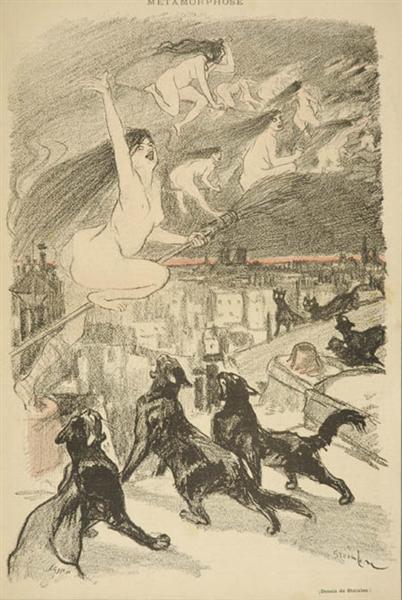
--
Théophile Alexandre Steinlen, Métamorphose, lithography, v. 1907.
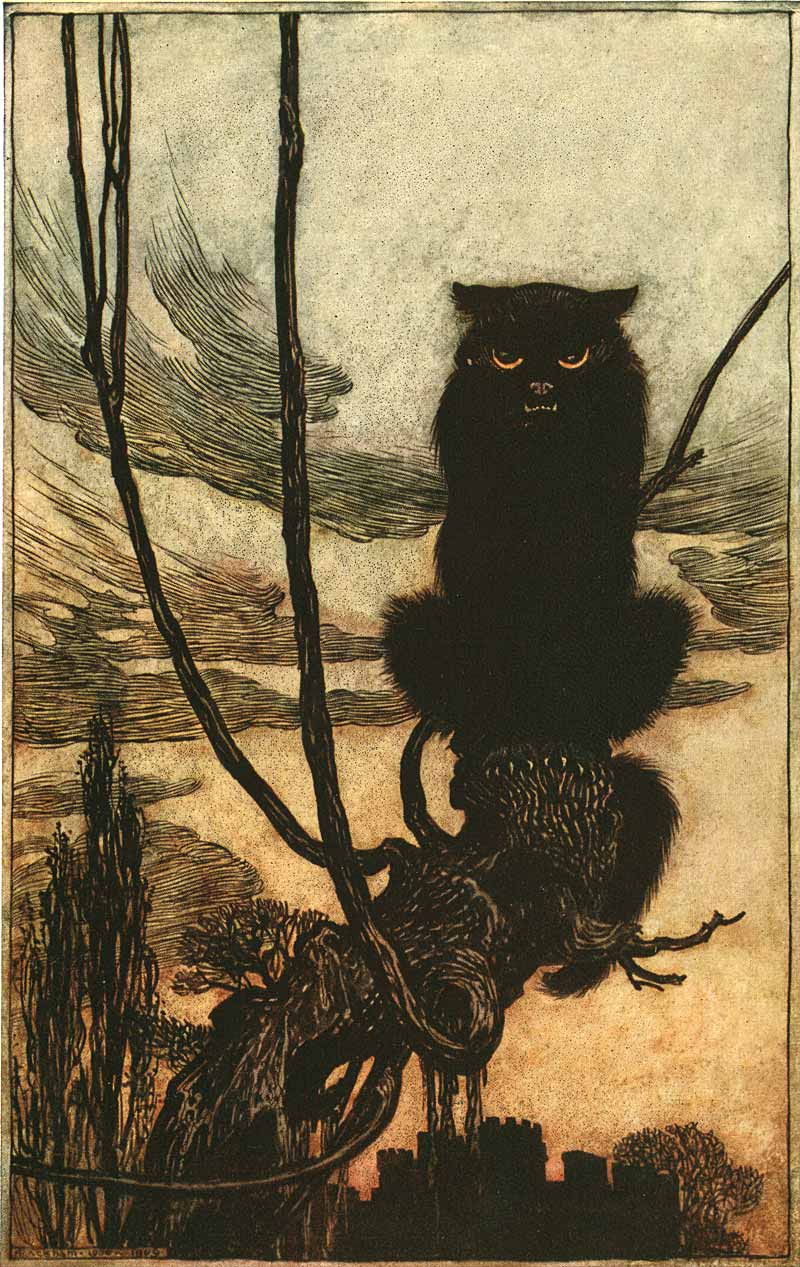
--
Arthur Rackham, By day she made herself into a cat, 1920.
Moreover, during the period when witchcraft trials were most frequent (16th-17th centuries), Britain was at the forefront of a change that would soon spread to the rest of the continent: pets were introduced into English homes, providing an ideal model for the creation and consolidation of the figure of the familiar[8]alongside his witch.

--
Perhaps the most famous black cat in pop culture: Salem Saberhagen, companion to the witch Sabrina in Sabrina the Teenage Witch, 1996-2003.
. . . To the bold companion of artists
In the nineteenth century, executions for witchcraft had long since ended in Europe[9] and the black cat entered literature: from a satanic creature, shrouded in popular superstition, it gradually became the "affectionate and insolent accomplice of writers"[10].He is also present in many works of art, his black fur presenting a beautiful graphic potential: in a few strokes of black ink, two light spots for the eyes and here is a black cat!
The texts of the beginning of the century continue to accuse the black cat of all the defects, while considering it as an attribute linked to witchcraft. However, in 1843, the publication of The Black Cat by Edgar Allan Poe described the little feline as an innocent victim of human cruelty.
Poe thus joined the impetus for the inclusion of cats in the Protection of Animals Act of 1835 - the aim was to protect them from the practice of skinning them alive to recover their fur and make rugs[11]… France[[12], it was not until 1850 that the abuse of domestic animals in public was criminalized, and then in 1959 that it was extended to private use. In Switzerland, the first constitutional provision dates from 1973[13].
The end of the 19th century saw the birth of a new way of looking at the black cat: from being a creature of misfortune, it became an affectionate companion, a bit cynical, while retaining a mysterious and magical aura.
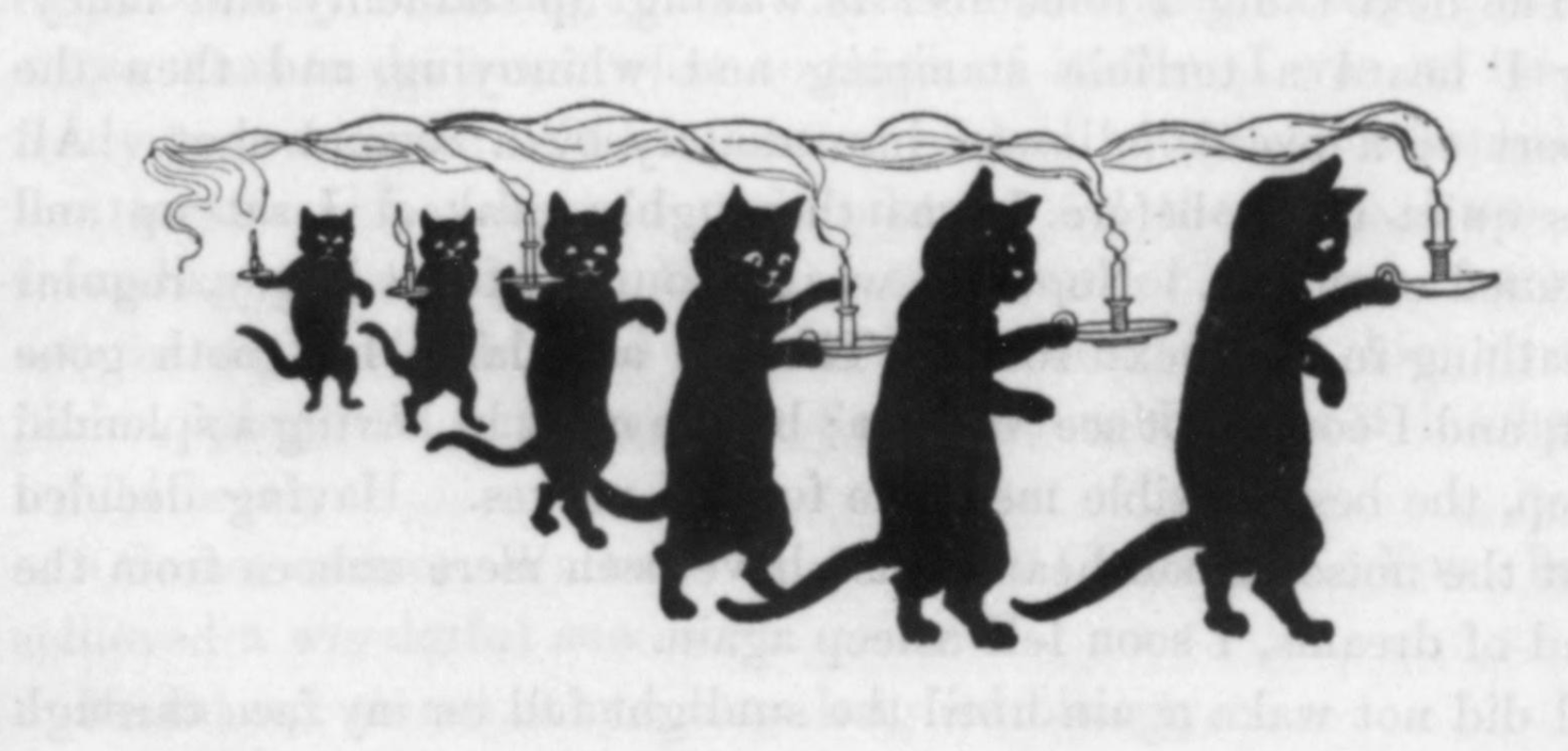
--
Image from The Black Cat magazine, October 1896, vol. 1, n°13.
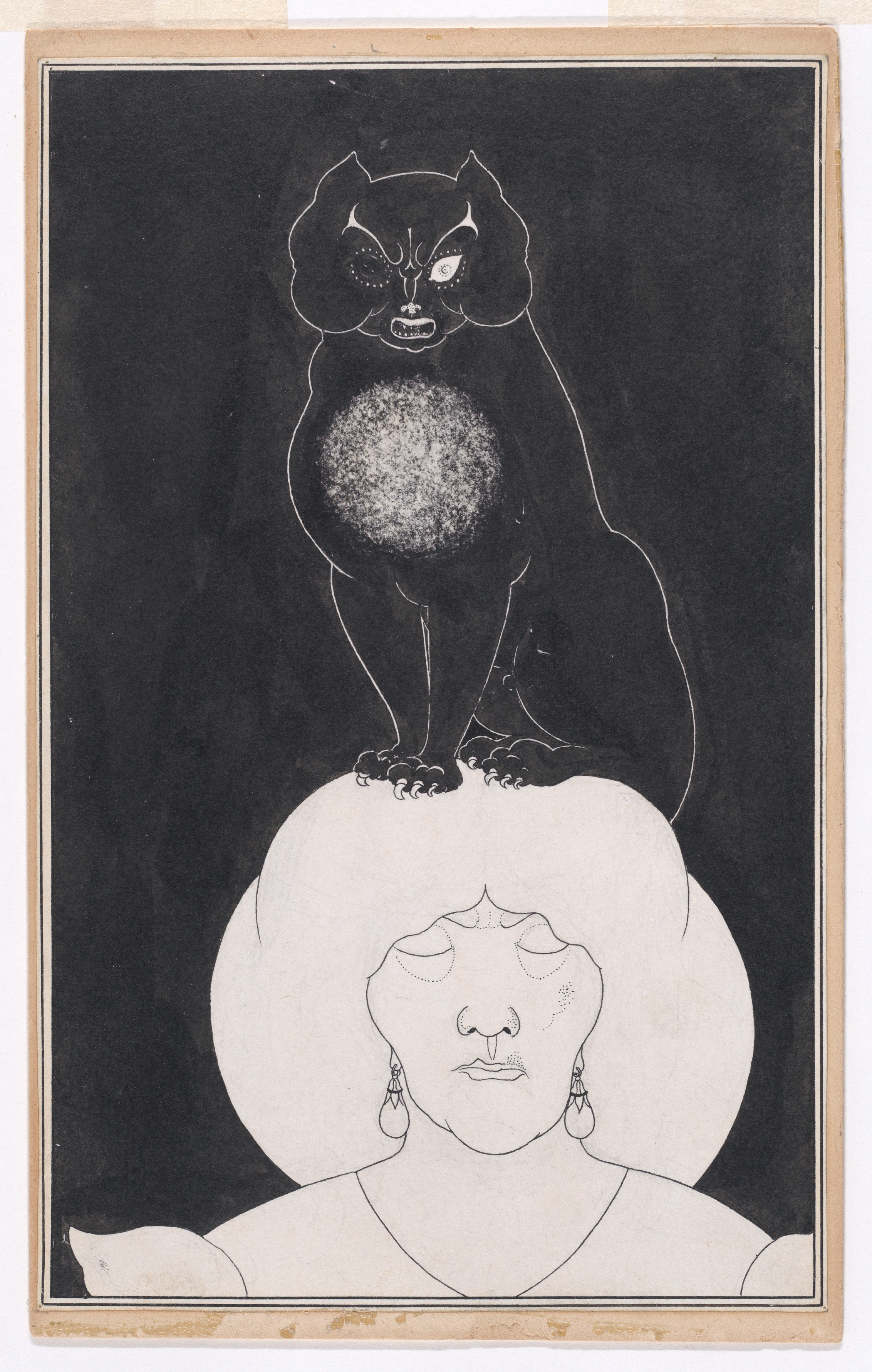
--
Aubrey Vincent Beardsley, The Black Cat, for Edgar Allan Poe's "Tales of Mystery and the Imagination," Chicago, 1895-96, pen, brush and India ink on graphite, 1894.
Icon of the Press
From Paris ... .
In addition, two new magazines were published at this time, which made the black cat their mascot: Le Chat Noir in Paris (1882-1895) and The Black Cat in Boston (1895-1922). In the Visual Contagions corpus, it is mainly in these two publications that the black cat motif circulates, with a few images taken from advertisements and published in other periodicals.
The magazine Le Chat Noir was founded in 1882 by Rodolphe Salis, one year after the opening of the eponymous cabaret in Montmartre - the name was chosen after the appearance of a black cat during the construction of the cabaret[14].The place became the haunt of Parisian bohemia, but also, quickly, that of social circles. The poster "Tournée du Chat Noir" drawn by Théophile-Alexandre Steinlen in 1896 remains today one of the most widespread images to embody the Paris prized by tourists. It is reproduced endlessly.
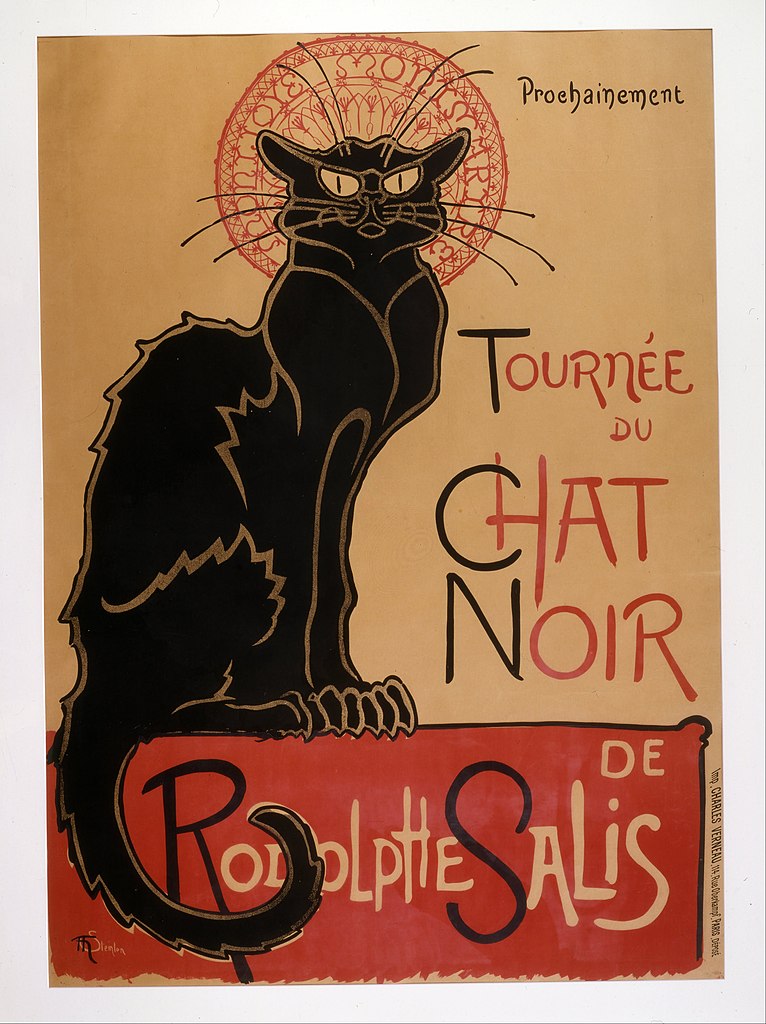
--
Théophile Alexandre Steinlen, Tour of Rodolphe Salis' Black Cat, lithograph, 1896.
As for the illustrated magazine, it appeared once a week. It promoted the cabaret while bringing together texts and illustrations by famous regulars: Rollinat, Verlaine, Richepin, Moréas, Mallarmé, Banville for the writing and Willette, Steinlen, Caran d'Ache for the drawing.[15].
The newspaper is instantly recognizable: a large sheet of paper folded in two and above all, on the first page, an illustration in a semicircle representing a black cat, its tail raised in front of two Montmartre mills.
. . . In Boston
The Black Cat of Boston, published from 1895, is a direct allusion to Edgar Allan Poe's black cat, as much as to that of the Parisian bohemian, at a time when artistic and literary modernity had become largely international. The Bostonian magazine uses the motif of the black cat throughout its pages. Often in the form of a cat's head, small illustrations punctuate the publication, from the cover to the lettering at the beginning of the texts.
The same illustration is sometimes repeated in several issues. Published between 1895 and 1922, the magazine specializes in the publication of short stories with a strange and original character.
A wink to the magical and bohemian past of the black cat symbol?
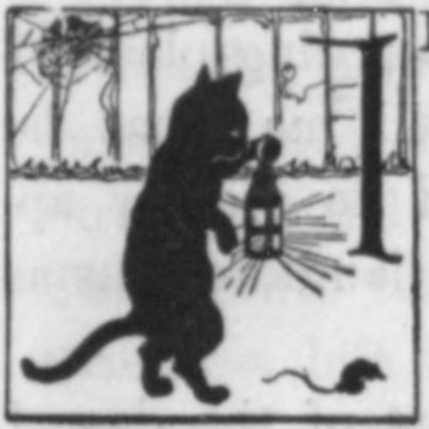
--
Letterheads from The Black Cat, mois d'octobre 1895-1900
... and Barcelona
In 1897, the cabaret Els Quatre Gats was opened in Barcelona, also inspired by the Parisian Black Cat. Frequented by Pablo Picasso in particular, and with him by Catalan and Spanish modern artists passing through Barcelona, the cabaret also published its own weekly review. The illustrated weekly Quatre Gats was published about sixteen times between February and May 1899.
The black cat finally became an icon of modernity.
A 20th century luxury icon
Is it linked to the consecration of the fin-de-siècle generation? To its close association with the theme of modernity?
In the years 1950-60, the black cat wins the pages of fashion magazines and advertising.
In Vogue in 1955, it replaced the model, with its paws slipped into heeled shoes. This image will then be chosen as an example in Art Directors Annual of Advertising Arts published in New York in 1957.
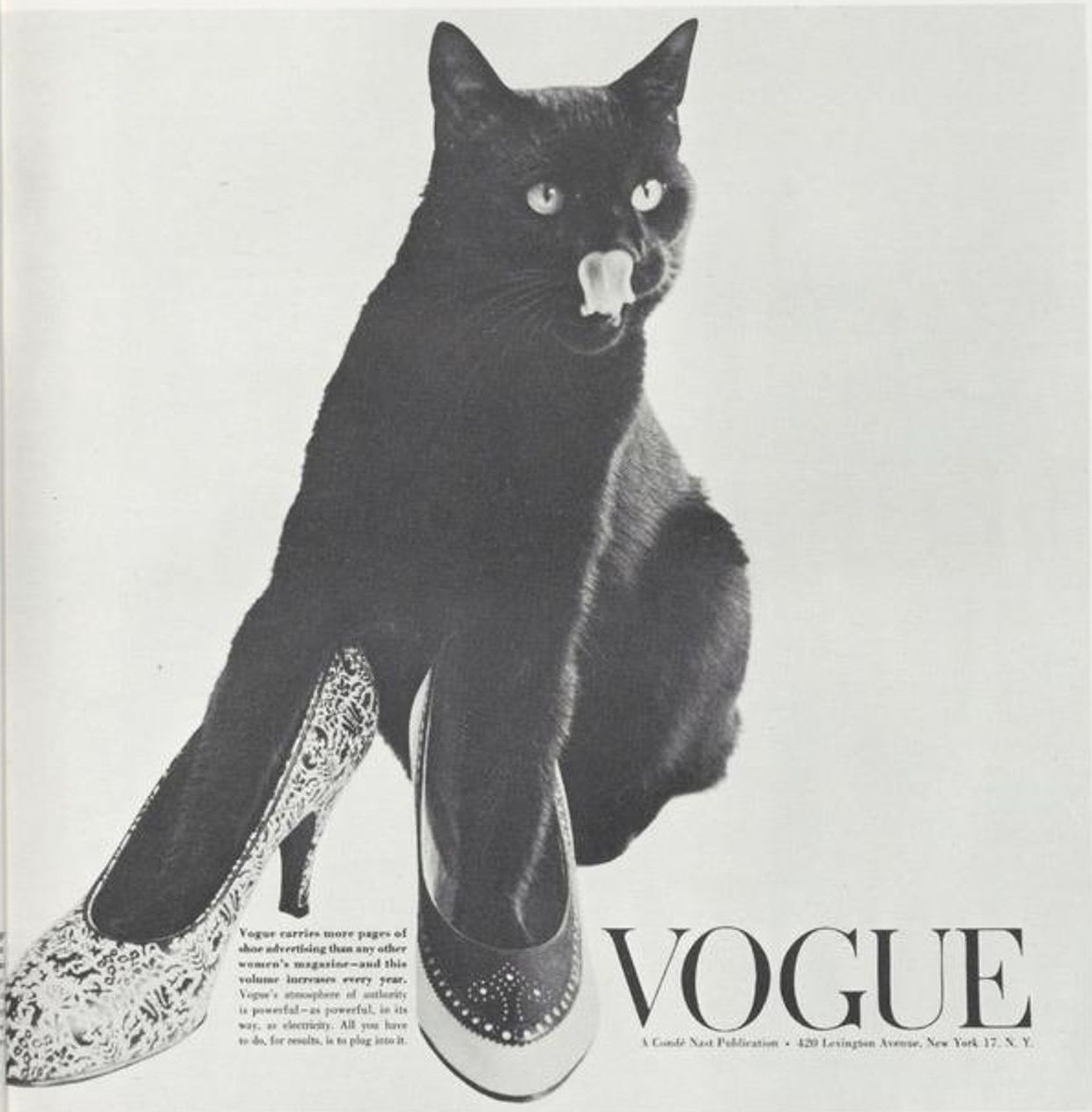
--
Fashion photograph that appeared in Vogue Art Directors Annual of Advertising Ats (New York City), 1 janvier 1957.
Three years later, we find the black cat sitting proudly next to four Benrus watches. Under the photograph is a slogan: "You'll swear your Benrus has nine lives, too! The marketing strategy equates the legend of the cat's nine lives with the durability and longevity of the timepiece.
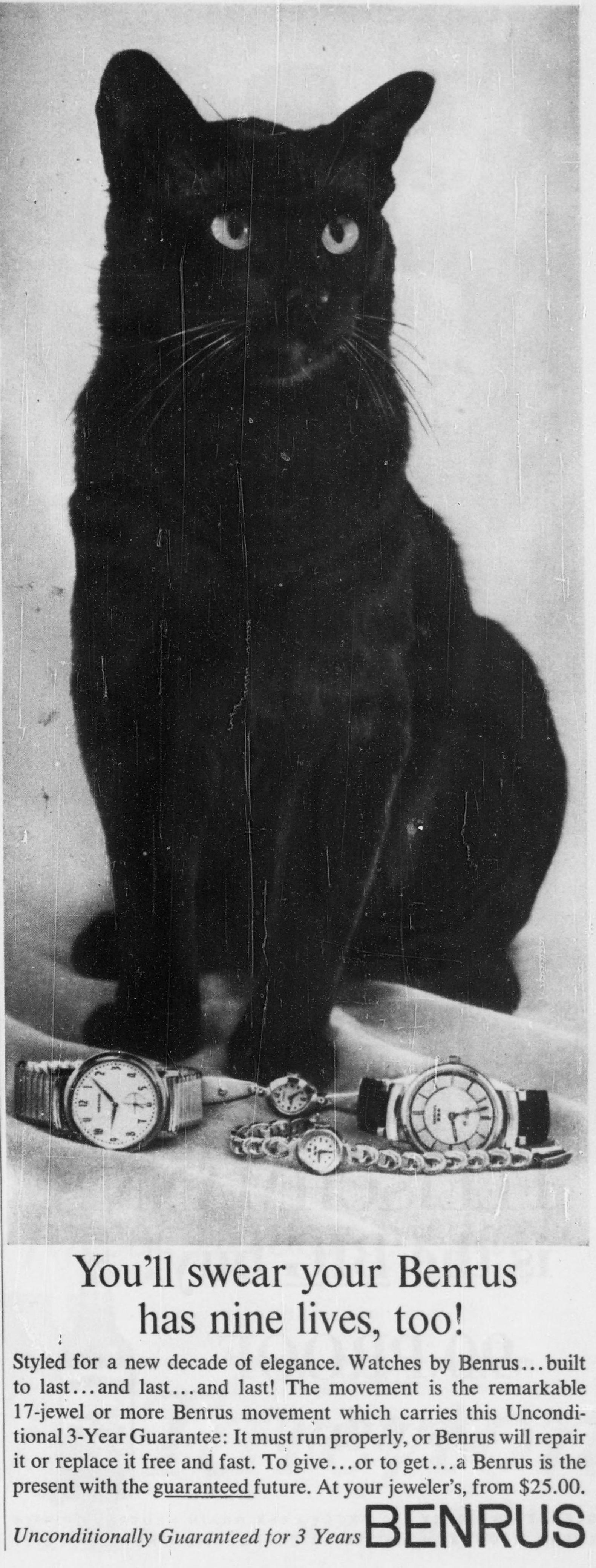
--
Advertisement for Benrus in Ebony Ebony (Chicago), 1 novembre 1960.
In 1962, it was Rolex that created a campaign playing on the elegant silhouette of a black cat drawn in ink, adorned with a cascade of jewelry.
This time, the audience targeted by the slogan is clearly feminine:
"Woman, she didn't care what time it was - but one day..."
The image is accompanied by a short poetic text, telling the story of a woman who "went about her life without caring about the time" until the day a man gives her a diamond-studded watch:
"And she loved... her Rolex."
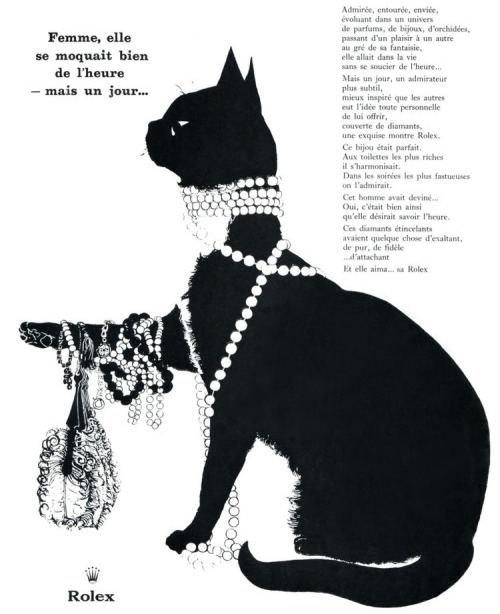
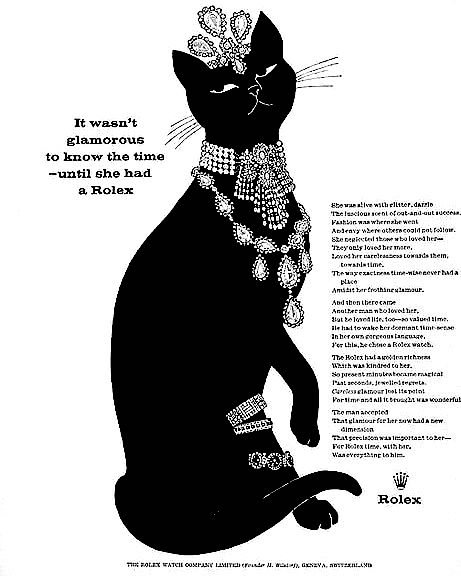
The black cat is here clearly assimilated to the stereotype of a carefree, superficial, a little insolent and especially venal woman, who is not interested in anything as long as it is not a luxury item. Numerous examples taken from advertising will reinforce these sensual, provocative and mysterious aspects of the symbolism of the black cat, from Lanvin to Boucheron through Givenchy or Cartier.
In the menacing shadow of witches or in front of the flashes of photographers?
The black cat occupies an ambiguous place in our culture today - a symbol of sensuality and freedom, it still embodies a bloody past linked to witchcraft, while purring alongside its human companions.
In the 20th century, the black cat was even chosen by anarchists for its independence and disobedience to orders - the exact opposite of the faithful and docile dog.
Hypersexualized, dressed in a tight black leather leotard almost fetishistic, whip in hand, the Catwoman of the DC Universe concentrates almost all these aspects.
Behind the mask of Catwoman, there is Selina Kyle, a woman from the world of prostitution. Seductive, ambivalent, provocative, dangerous, she plays a femme fatale to Batman, between enemy and lover.
At Halloween, the black cat costume is one of the classics, especially popular with women. But to dress up as a black cat, it is difficult to distance oneself radically from that of the comic book heroine.
The black cat occupies a complex place: since the time of the pyres, it has been able to inspire creative minds, to impose itself as a reference to modern art and literature as well as to the liberated mores of the fin-de-siècle bohemians - until becoming the muse of the biggest luxury brands in their globalized advertising campaigns. Nevertheless, the black cat still carries in its wake some superstitious, magical and, above all, elusive memories...
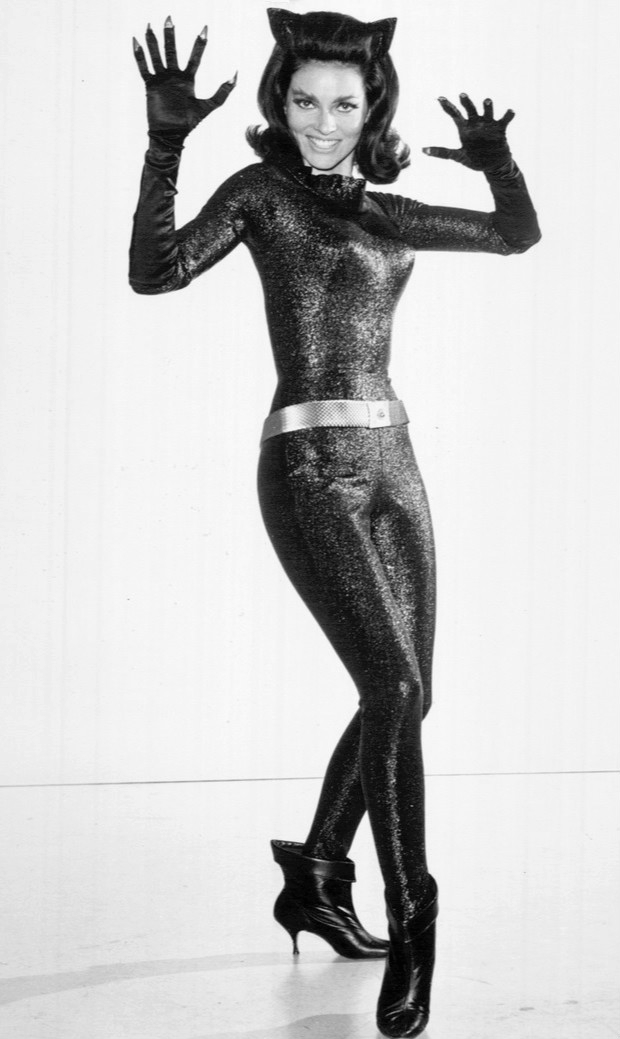
--
Photograph of Lee Meriwether wearing her Catwoman costume in Batman, 1966.
Source : Wikimedia Commons.
Notes
« Black cats shunned at rescue shelter because they don't look good in selfies » in The Telegraph, 29.01.2018 [en ligne]. https://www.telegraph.co.uk/news/2018/01/29/black-cats-shunned-rescue-shelter-dont-look-good-selfies/
[2] Rodriguez Rachel, « To be a black cat on Halloween » in CNN, 31.10.2014 [en ligne]. https://edition.cnn.com/2014/10/31/living/black-cats-irpt/index.html
[3] Palmer Ashley, « Keep Your Animals Safe and Happy This Halloween » in Peta, 16.10.2019 [en ligne]. https://www.peta.org/living/animal-companions/keep-animals-safe-happy-halloween/
[4] Tassone Claudia, « Le chat et la sorcière. Des premières attestations de l’adoration du chat-diable jusqu’au chat des procès de sorcellerie et des traités de démonologie », Reinardus, 2019, 31(1), pp. 182-200.
[5] Théry J. (dir.), APOSCRIPTA database – Lettres des papes, CIHAM/UMR 5648, éd. électronique TELMA (IRHT), Orléans, 2017 [en ligne], acte n. 26666 (aposcripta-666), http://telma-chartes.irht.cnrs.fr/aposcripta/notice/26666 (mise à jour : 17/02/2022). Voir aussi Engles Donald W., « Appendix III: Pope Gregory and the Vox in Rama » in Classical Cats: The Rise and Fall of the Sacred Cat, Routledge, 2001, p. 183.
[6] While the cat as a familiar will appear later, the first written mention of a relationship between a witch and her familiar dates from about 1123 (William of Malmesbury, Stubbs William, Willelmi Malmesbiriensis Monachi De Gestis Regum Anglorum libri Quinque; Historiae Novellae Libri Tres. (Rerum Britannicarum medii aevi scriptores; no. 90), 1887, London: Nabu Press). See Parish Helen, "'Paltrie Vermin, Cats, Mise, Toads, and Weasils': Witches, Familiars, and Human-Animal Interactions in the English Witch Trials" in Religions, 10, no. 2: 134, 2019 [online]. https://doi.org/10.3390/rel10020134
[7] « mouse, catte, or some other visible creature », Perkins William, A Discourse of the Damned Art of Witchcraft, Cambridge: C. Legge, 1608, pp. 203 in Parish, op. cit..
[8] Boria Sax (2009) « The Magic of Animals: English Witch Trials in the Perspective of Folklore » in Anthrozoös, 22:4, 2009, p. 327. https://doi.org/10.2752/089279309X12538695316068
[9] Witchcraft was decriminalized in France by the edict of July 1682 and the last execution for witchcraft in Europe was that of Anna Göldi in 1782 in Glarus, Switzerland. In England, even if persecutions disappeared, it was not until 1951 that the Witchcraft Act was repealed, replaced by the Fraudulent Mediums Act, still in force today.
[10] Bergès Louis, « L’ascension du modèle romantique du chat noir dans la poésie et la fiction française du XIXe siècle : de l’animal diabolique à l’ami des hommes » in L’animal : une source d’inspiration dans les arts, Paris : Éditions du Comité des travaux historiques et scientifiques, 2018 [en ligne], §2. https://doi.org/10.4000/books.cths.4236
[11] Kean Hilda, « From Skinned Cats to Angels in Fur: Feline Traces and the Start of the Cat-Human Relationship in Victorian England » in Cahiers victoriens et édouardiens, 88, Automne 2018 [en ligne], §3. https://doi.org/10.4000/cve.3994
[12] Pierre Éric, « Réformer les relations entre les hommes et les animaux : fonction et usages de la loi Grammont en France (1850-1914) » in Déviance et Société, 2007/1 (Vol. 31), p. 65-76 [en ligne]. https://doi.org/10.3917/ds.311.0065
[13] Before this date, the protection of animals was the responsibility of the cantons, only Zurich, Fribourg, Vaud and Geneva had a law. Message concernant la révision de la loi sur la protection des animaux, Fedlex, published on 11.02.2003 (FF 2003 595) [online] https://fedlex.data.admin.ch/eli/fga/2003/118
[14] Laporte Sophie [éd.], Autour du Chat noir : arts et plaisirs à Montmartre, 1880-1910, Paris : Skira Flammarion, 2012.
[15] he publication of Le Chat Noir was relaunched in 2018 in the same form: a large sheet folded in half. See: : https://www.journallechatnoir.com/l-épopée

